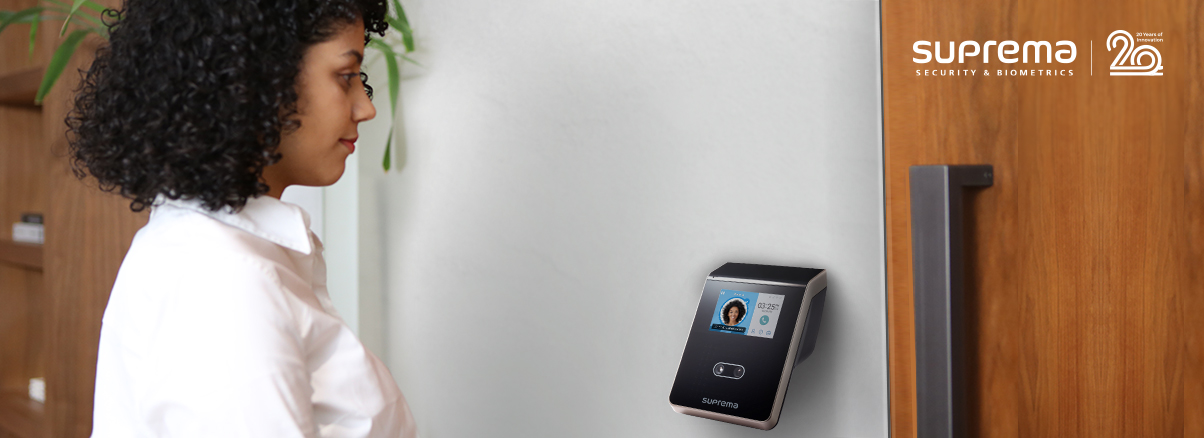- PRODUCTS
- Security Platform
- BioStar X | On-Prem SecurityNEW
- BioStar Air | Cloud Security
- BioStar 2
- Access Control
- Access Control Unit
- Biometric Readers
- RFID Readers
- Mobile Credential
- Peripherals
- Wireless Door Locks
- SOLUTIONS
- SUPPORT
- ABOUT
- device_hubHUB
- Blogs & Articles

Facial Authentication technology has come a long way since it first came to market several years ago. Initially plagued with technical challenges and widely viewed as a futuristic solution, facial authentication is now firmly implanted in numerous consumer and business products and applications. New advancement in software, specifically in the areas of algorithms, neural networks and deep learning and/or artificial intelligence (AI), have all dramatically improved both the performance and accuracy of facial authentication further expanding its use for an increasing number of applications.
From a purely business perspective, facial authentication’s powerful identification and authentication capabilities make it ideal for two primary applications: first as a security tool, and second as a workforce management solution.
The Touchless, Accurate Credential Solution
Even before the COVID-19 pandemic, the touchless nature of facial authentication as an access credential was gaining traction with physical and cyber security professionals. By using an individual’s face as an access control credential, facial authentication eliminates the need and expense of physical cards and proximity devices, or the need to physically enter PIN codes. In addition, facial authentication readers meet the new emerging need to limit physical exposure to germs and viruses by offering a highly accurate touchless access control credentialing solution.
As a workforce management tool, facial authentication helps preserve the health of employees checking into work, while providing management with an infallible means of documenting employee time and attendance while providing a detailed history of overall workforce activity and individual personnel tracking. Both of which have been longstanding challenges due to easily compromised time tracking systems and practices. Now, nothing is left to question based on hard data.
With the growing popularity of facial authentication technology, there are many choices already available with more undoubtedly on the way. Selecting the right solution for your specific access control and/or workforce management application is dependent on a very wide range of variables. But there are a few core characteristics that you should look for when evaluating facial authentication readers.
Wide and Near-Angle LEDs
Most facial authentication terminals employ some form of IR (Infrared) technology to help ensure high visibility by the unit’s image sensor. This often limits where the unit can be installed such as outdoors or near windows due to strong ambient light. More advanced facial authentication readers employ as many as 80 wide-angle near infrared LEDs and 60 narrow-angle near infrared LEDs, allowing the unit to recognize faces even in full daylight and brightly lit environments (not direct sun). This enables installation at indoor locations near windows, lobbies and building entries.
3D Pixel Intensity Distribution Analysis
Another facial authentication reader advancement to look for involves three-dimensional pixel intensity analysis. Ambient lighting contains ultraviolet rays which can negate near infrared LED lighting, and can also cast shadows making it difficult for a facial authentication reader to pinpoint the facial authentication points required for identification and authentication. Three-dimensional pixel intensity distribution analysis minimizes the effects of ambient light when acquiring facial images by minimizing lighting contrasts. As a result, it is easier for the algorithm to recognize the shape of the face enabling it to extract more facial features and create higher quality face templates, which are critical for accurate facial authentication.
Functional Ergonomics
The angle and position of a facial authentication reader directly impact the performance of the unit. Facial Authentication readers with different viewing angles for built-in visual and infrared cameras allows users to stand at positions that are most suitable for facial authentication with little or no effort of contortions. This results in a faster, more comfortable, and convenient user experience.
High Performance Processing
Like any intelligent edge device, the performance of a facial authentication solution is directly reliant on its processing power. New advanced facial authentication readers deliver exceptional performance by employing enhanced face template extraction technology combined with powerful processor. For example, a facial authentication reader with a 1.4 GHz quad-core processor can perform up to 3,000 facial database matches (1:N) within one second. More advanced solutions also feature Group Matching functionality capable of executing up to 30,000 matches within one second.
Live Face Detection
It is most important that the facial authentication readers you evaluate are capable of analyzing faces in real time to maintain fluid entry/egress even during high volumes of employee traffic. Hardware-dependent live face detection systems employing technologies such as facial thermogram authentication and facial vein authentication require expensive hardware components, provide less accurate matches and slower authentication performance, which is counterintuitive for mainstream access control and workforce management applications.
Dual Authentication for Added Security
Although the use of an advanced facial authentication reader provides the convenience, health benefits and cost-savings of touchless identification and authentication, there are many applications where more than one credential may be necessary to ensure the highest levels of security. Advanced facial authentication readers with multimodal, multifactor credentialing capabilities provide this added security benefit. For example, facial authentication readers that support multiple RFID proximity devices supporting 125 kHz and 13.56 MHz provide varying degrees of protection and greater implementation versatility.
Videophone or Intercom Capabilities
Facial Authentication readers with multifunctionality can solve several challenges with one solution. A perfect example includes devices with SIP (session initiation protocol) videophone capabilities which effectively eliminate the need and associated expense of installing separate intercom devices while adding another layer of security to one’s facility.
The COVID-19 pandemic, and hopefully soon to follow post-pandemic world, have surely accelerated the need for highly accurate, cost-efficient, and reliable facial authentication technologies to help get people back to work safely. Selecting the right facial authentication solution for your specific access control and/or workforce management is now more important than ever before, making a little extra due diligence during the evaluation process a smart decision.
Attribute to: Hanchul Kim, Managing Director at Suprema











